eOrganic authors:
Olivia Smith, School of Biological Sciences, Washington State University
William Snyder, Department of Entomology, Washington State University
Introduction
Growers often find bird nests around structures where food is washed, packaged, stored, and shipped. However, identification of these nests can be challenging. This article provides guidance on identifying nests of bird species commonly found nesting in barns, sheds, or other farm buildings. Most bird species included in this article are known to carry bacteria that cause food safety problems, such as pathogenic E. coli and Salmonella. However, some of these birds are also known to eat pest insects or rodents, so promoting nesting in appropriate areas can provide valuable natural pest control. Our article also makes recommendations for discouraging nesting in undesirable locations, such as food processing areas, and for promoting it elsewhere where birds can be primarily beneficial. We have organized the article by bird species that have invaded North America from Europe and Asia, and by species that are native to North America. Native species are protected under the Migratory Bird Treaty Act (MBTA) and cannot be harassed or have their nests tampered with.
Invasive Species
European Starling (Sturnus vulgaris)
Figure 1. Group of European Starlings perched on a farm structure. Note the yellow bill and pinkish-orange legs that distinguish starlings from similar-looking native blackbirds. More identification information can be found online here. Photo credit: Olivia Smith.
The European Starling (hereinafter starling; Fig. 1) was introduced to Central Park in 1890 and 1891 by Shakespeare enthusiasts who wanted all of the birds in Shakespeare's plays to be found in the park. If only they had never gone to the theater! After several unsuccessful releases, populations took off, and the starling has arguably become the most successful (and loathed) invasive bird species in North America. Though starlings are most numerous in human-dominated landscapes, they can be detrimental to native bird species due to competition for cavity nesting sites (Cabe, 1993). Although starlings do compete with more desirable native species for natural tree cavities, they have amazing flexibility in nest site selection and will also use cavities in structures (Fig. 2). Starlings construct nests inside of cavities with materials that can fall and dirty equipment or contaminate food with associated feces. Nests are easiest to locate by watching adults fly in and out of cavities. Starlings are known to vector pathogenic E. coli O157:H7 (Williams et al., 2011) and Salmonella enterica (Carlson et al., 2011; Kirk et al., 2002) and should be discouraged from nesting near food operations. Specific recommendations on starling nest management can be found here.

Figure 2. Lean-to style food wash station with open rafters that allow starling nesting. Circled is the cavity where starlings were observed nesting. Photo credit: Olivia Smith.
Starlings will begin choosing nest sites as early as February (Cabe, 1993) and can begin laying eggs between mid-March and mid-June, depending on latitude (Kessel, 1957). Birds typically lay around 4-5 eggs per clutch (a group of eggs) and have 1-2 broods (a group of nestlings hatched at the same time). Eggs are bluish or greenish white and approximately 2.7–3.2 cm long by 1.9–2.3 cm wide. Incubation generally takes 12 days (Ricklefs and Smeraski, 1983). Nestlings fledge (depart from the nest) on day 21–23 after hatching and typically continue to rely on the parents to supplement their food for 10–12 days (Cabe, 1993). Starlings are omnivorous (Wilman et al., 2014) and eat pest insects, predatory arthropods, and crops (Cabe, 1993; Somers, 2002). As with most bird species, the number of insects in the diet increases during the breeding season while chicks are growing and insect abundance is high (Cabe, 1993).
House Sparrow (Passer domesticus)
Figure 3. Invasive House Sparrow occupying native Cliff Swallow nest. Note the black bib on the throat, brown eye stripe, gray gap, and solid light gray belly that distinguish the male House Sparrow from native species. More identification information can be found online here. Photo credit: Olivia Smith.
Similar to the story of the European Starling, the House Sparrow (Fig. 3) was introduced to North America in the 1850s and has now invaded all of North America. This species is highly associated with human-dominated landscapes. The House Sparrow has amazing nest site selection flexibility and can nest in nest boxes, inside and on buildings (Fig. 4), in stolen nests of other species (Fig. 3), or nest in and on trees. Intense competition for nesting cavities with native species can occur. Nests are constructed from a variety of materials such as dried plant material, feathers, or string. Like the European Starling, nests are most easily identified by watching birds fly to them (Lowther and Cink, 2006). Nest debris often accumulates under the nest location, causing food safety concerns when House Sparrows nest in food processing areas. This species is known to carry E. coli and Salmonella spp. (Morishita et al., 1999; Kirk et al., 2002) so should be discouraged from nesting near areas where food is present. Specific recommendations on House Sparrow nest management can be found here.

Figure 4. House Sparrow nests in barn rafters. Chicken wire was used to discourage nesting, but the sparrows were able to get under the netting. Photo credit: Olivia Smith.
Nest building begins in February and March, and egg laying begins in March. House Sparrows have amazing fecundity, can have 4–8 broods per season, and can lay between 1–8 eggs per clutch (average about 5 eggs). Eggs are oval; about 2.1 cm long by 1.6 cm wide; and white, greenish-white, or blueish-white with gray or brown spots. Birds begin incubation after laying the final egg of a clutch. Incubation generally lasts 10–14 days. Chicks generally fledge after 14 days. Fledglings independently feed themselves after 7–10 days (Lowther and Cink, 2006). Insects, including alfalfa weevils and other pests, comprise about 68% of the diet of young birds (Lowther and Cink, 2006), while adults are primarily granivorous, often consuming livestock feed (Wilman et al., 2014).
Rock Pigeon (Columba livia)
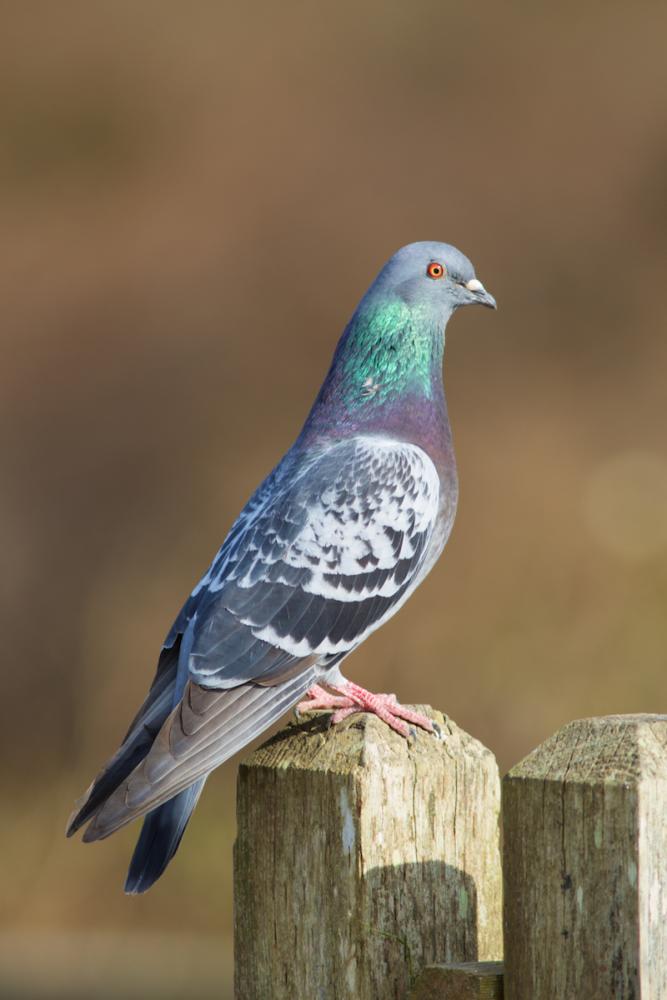
Figure 5. Rock Pigeons have beautiful iridescent green and purple napes. Their overall plumage is a dark blue-grey, setting them apart from invasive Eurasian Collared-Doves and native Mourning Doves. Rock Pigeons are most common in landscapes dominated by humans. Photo credit: Robin Horn, Tall Rock Pigeon, License.
Domesticated Rock Pigeons were introduced into North America by Europeans in the 1600s and readily went feral. Like the common name Rock Pigeon implies, this species historically nested on cliffs and in caves, so ledges of modern human structures are quite suitable as long as flat surfaces occur (Fig. 5; Lowther and Johnston, 2014). Nests are typically flimsy constructions made of straw, stems, sticks, or human objects. Rock Pigeons are known to carry pathogenic E. coli (Kobayashi et al., 2009) and Salmonella enterica (Kirk et al., 2002) and should be discouraged from nesting near food processing areas.
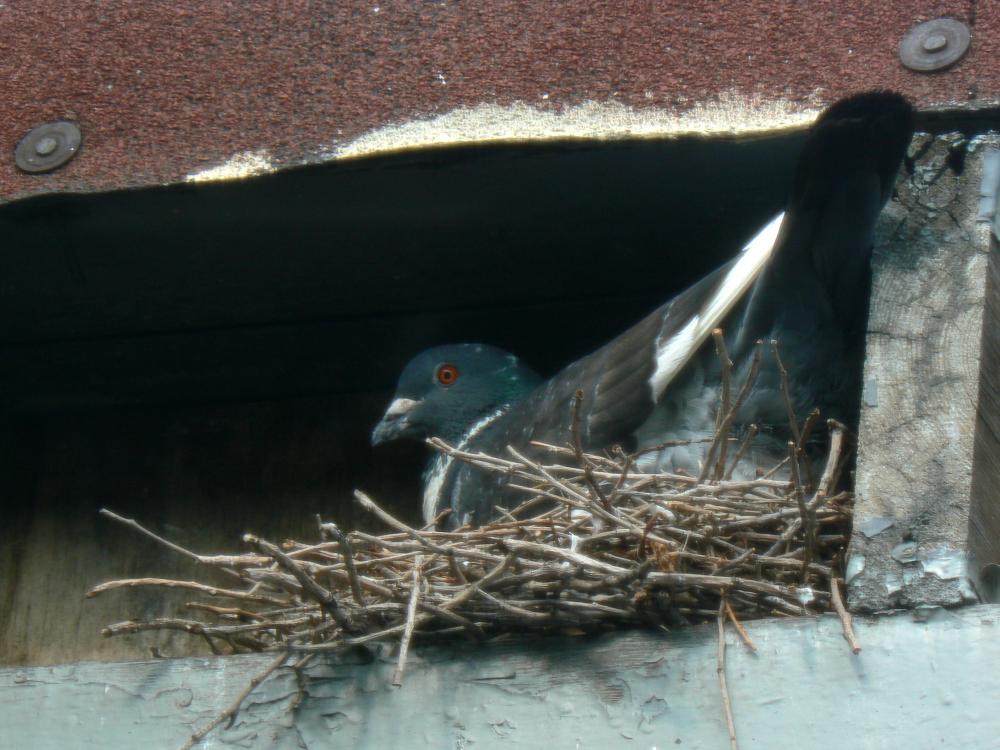
Figure 6. Rock Pigeon sitting on nest. Nests are typically simple with some sticks, stems, or straw placed on a flat ledge. Photo credit: Benny Mazur, Rooftop pigeon, License.
Nesting begins mid-February. Birds lay two eggs, and incubation begins after laying the second. Eggs are white and average 3.8 cm in length by 2.9 cm in width. Eggs typically hatch after 18 days, and chicks fledge on day 25–32. In some areas, Rock Pigeons can nest year- round due to chicks feeding on seeds and crop milk (a secretion from the crop of pigeons regurgitated to feed chicks). Mean number of nesting attempts per year is 6.5 (Lowther and Johnston, 2014). Adults are primarily granivorous (Wilman et al., 2014).
Native Species
Under the Migratory Bird Treaty Act, one cannot tamper with native bird nests or eggs. Therefore, with native species, prevention of nesting in undesirable areas and encouraging nesting in desirable areas is key (more details below).
Barn Swallow (Hirundo rustica)
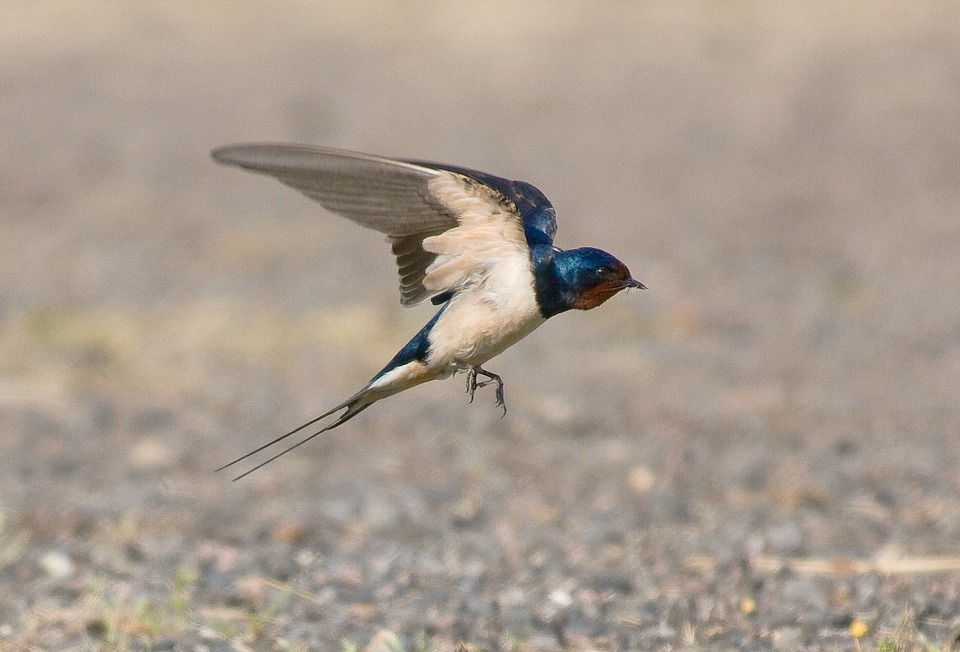
Figure 7. Adult Barn Swallow in flight. Note the long tail streamers which set it apart from other adult swallows. Photo credit: Denise Coyle, Barn Swallow
The Barn Swallow is a species most growers love to see gliding effortlessly through the air eating pest insects (more information can be found here) but often causes disgruntlement due to its nesting habits. Historically a species that nested in caves, the Barn Swallow now primarily nests under the eaves of buildings or inside artificial structures (Fig. 7). Barn Swallows build open-cup nests from mud on the walls of structures. They often nest colonially (Brown and Brown, 1999). Pathogenic E. coli has been found in Barn Swallows (Nielsen et al., 2004), so nesting above food processing areas should be discouraged.
Figure 8. Barn Swallow nest. Unlike the similar Cliff Swallow, Barn Swallow nests are open cup. Photo credit: Olivia Smith.
Barn Swallows have a vast global distribution, so there is considerable variation in life history attributes within the species. Birds typically begin nest-building within two weeks after returning to the breeding grounds (Brown and Brown, 1999). Females typically lay between 4–8 eggs (Shields and Crook, 1987). Eggs have an ovate to elliptical ovate shape and are creamy or pinkish white with brown, lavender, and gray spots. Egg size averages 1.9 cm long by 1.4 cm wide. Barn Swallows often have 2 broods per year but can have as many as 4. Incubation lasts about 12–17 days. Chicks fledge around day 18–27. For up to 2 weeks, fledglings rely on parents for feeding (Brown and Brown, 1999). Barn Swallows eat almost exclusively insects (Wilman et al., 2014; more information can be found here).
Cliff Swallow (Petrochelidon pyrrhonota)
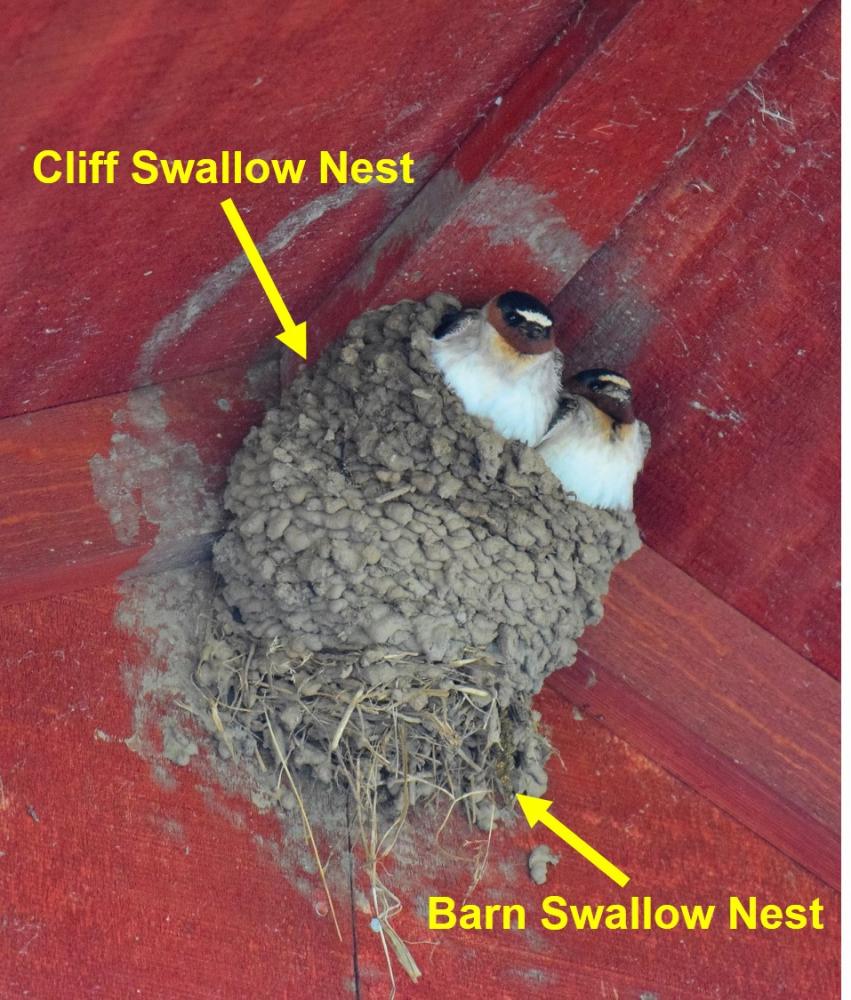
Figure 9. Cliff Swallow adults in nest. Cliff Swallow nests are enclosed structures with the entrance hole at the top, unlike the open-cup Barn Swallow nest. Apparent is the telltale white forehead that distinguishes them from the Barn Swallow. Note the old Barn Swallow nest under the newer mud of the Cliff Swallow nest. Photo credit: Olivia Smith.
Historically, the Cliff Swallow nested colonially under ledges of canyons in the West (Fig. 8). Human land usage allowed a range expansion because modern highway culverts, bridges, and buildings became manmade "cliffs" for Cliff Swallows to build nests on (Brown et al., 2017). Like the Barn Swallow, the Cliff Swallow builds nests from mud, but unlike the Barn Swallow, the Cliff Swallow's nest is enclosed and looks like a gourd (Fig. 8). Cliff Swallow colonies have been associated with increased environmental E. coli concentrations (Sejkora et al., 2011), so nesting should be discouraged above food packing areas.
Nest building typically begins within a few weeks of arrival to the breeding grounds. Arrival date and subsequent nest building varies by latitude and can start as early as March. The outside of nests are built entirely from mud, unlike Barn Swallow nests (Fig. 8), though birds do line the inside with grass. Clutch size varies from 1–6 eggs and averages about 3. Cliff Swallows usually have one brood but can have two if the first fails (Brown et al., 2017). Eggs are white, creamy, or pinkish with brown speckles or blotches. Cliff Swallow eggs average 2.0 cm in length by 1.4 cm in width. Incubation ranges from 11–16 days and averages around 13.6 (Grant and Quay, 1977). Chicks normally fledge between days 20–26, depending on the region. Fledglings rely on parents for food for the first 3–5 days (Brown et al., 2017). Like the Barn Swallow, Cliff Swallows eat almost exclusively insects (Wilman et al., 2014; more information can be found here).
Black Phoebe (Sayornis nigricans)
Figure 10. Black Phoebe perched on deer fence. Note the white belly contrasting against the otherwise black feathers and the slightly crested head feathers. Black Phoebes often bob their tails while perched, a characteristic of the phoebes. Photo credit: Olivia Smith.
The Black Phoebe (Fig. 10) has a small distribution within the continental United States but is frequently found on California organic farms foraging for insects. Natural nest sites include sheltered rock faces, streamside boulders, and hollow tree cavities. Like many other species in this article, human-built structures have increased densities of Black Phoebes by providing artificial nest sites. Black Phoebe nests (Fig. 11) appear quite similar to Barn Swallow nests. Nests are open cup, plastered to vertical surfaces, and composed of mud and plant material such as stems and small roots (Wolf, 1997). No current evidence has demonstrated Black Phoebes carry human enteric pathogens. However, Black Phoebes are known to frequent cattle troughs (Wolf, 1997), which is a known transmission point of human enteric pathogens between livestock and wild birds (Carlson et al., 2010). Therefore, growers should use caution due to little data existing on Black Phoebe pathogen rates.
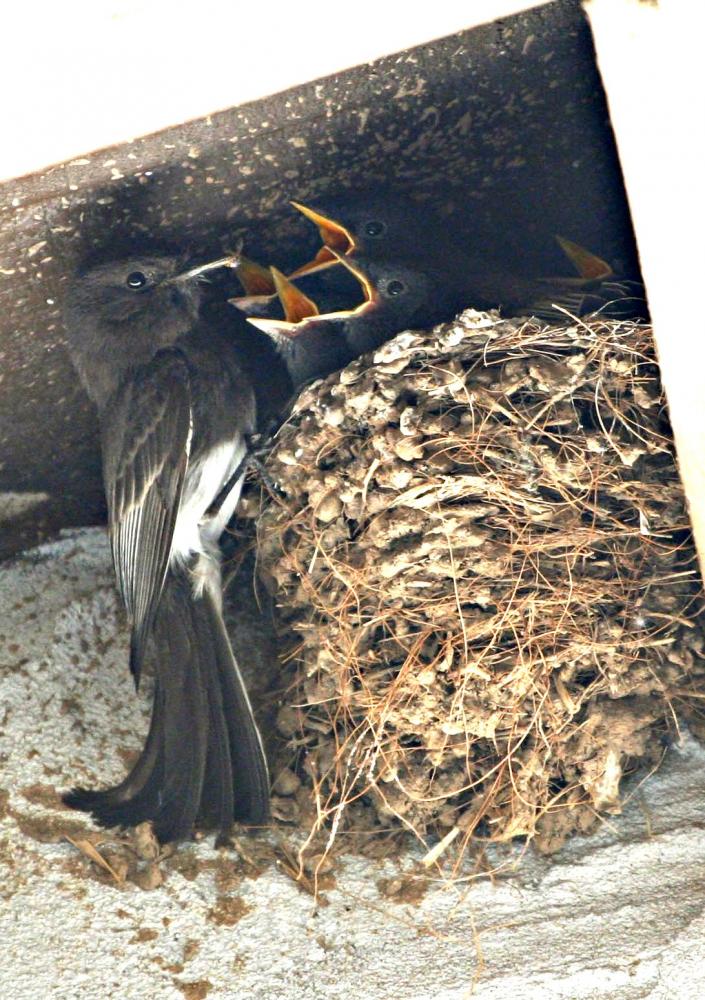
Figure 11. Black Phoebe adult feeding chicks in open cup mud nest. Photo credit: Glorietta13, Black phoebes, CC BY-NC 2.0
Nest building typically begins in early March. Black Phoebes generally raise 1–2 broods per season with a clutch size of 1–6 eggs. Eggs are ovate to short ovate and white, sometimes with light spots around the large end. Eggs are typically 1.9 cm in length by 1.5 cm in width. Incubation averages 16–17 days. Chicks fledge between days 18–21. Fledglings are dependent on adults for the first 7–11 days (Wolf, 1997). Adults and chicks are almost exclusively insectivorous (Wilman et al., 2014).
American Robin (Turdus migratorius)
Figure 12. American Robin perched on fence post holding invertebrate prey. Photo credit: Olivia Smith.
The American Robin (Fig. 12) is, perhaps surprisingly, a thrush. To the disdain of many growers, its diet is largely comprised of beneficial invertebrates such as earthworms in the early breeding season, and switches to primarily fruits in fall and winter. It is adapted to live in many habitats and is common on farms and urban settings, as well as more forested settings like other thrushes (Vanderhoff et al., 2016). Like its habitat usage, its nest placement also has flexibility. Robins often place nests in shrubs, trees, or on structures, as long as the nest is on a firm support (Fig. 13). The nest is an open cup, constructed from mud, dead grass, and twigs on the outside, with a lining of fine dead grass pieces. One study found high prevalence of E. coli in American Robins (44.8%), though it did not distinguish pathogenic from non-pathogenic strains (Parker et al., 2016), so risk of American Robins carrying pathogenic E. coli is unclear. The USGS database Wildlife Health Information Sharing Partnership (WHISPers) reports several suspected cases of Salmonellosis in American Robins, suggesting they may vector Salmonella enterica to produce if allowed to nest near produce wash stations.
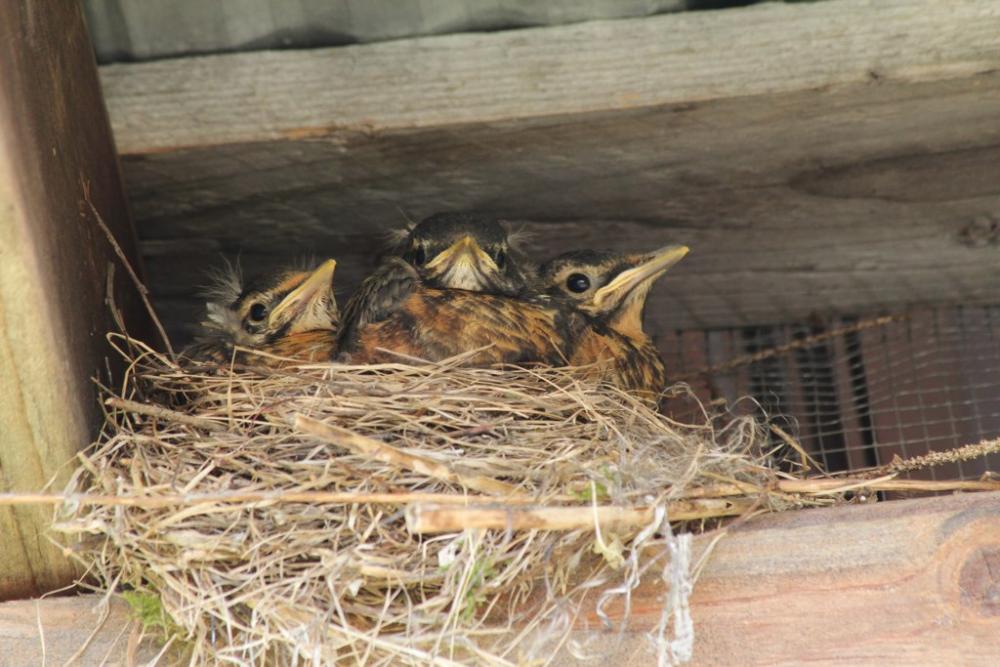
The American Robin is one of the most widely distributed species in North America, so onset of breeding varies by location, and occurs between April and June (Vanderhoff et al., 2016). Robins typically lay 3–4 eggs per clutch and have 2 broods per year. Eggs are a beautiful sky blue or green-blue color and average 2.8–3.0 cm in length by 2.1 cm in width (Fig. 14). The incubation period is generally 11–14 days (Howell, 1942). Nestlings typically fledge around day 13 after hatching (range 9–16 days; Howell, 1942). Parents typically begin a second brood within days of the first fledging. For the second clutch, once incubation begins, males feed fledglings while females incubate (Weatherhead and Mcrae, 1990).
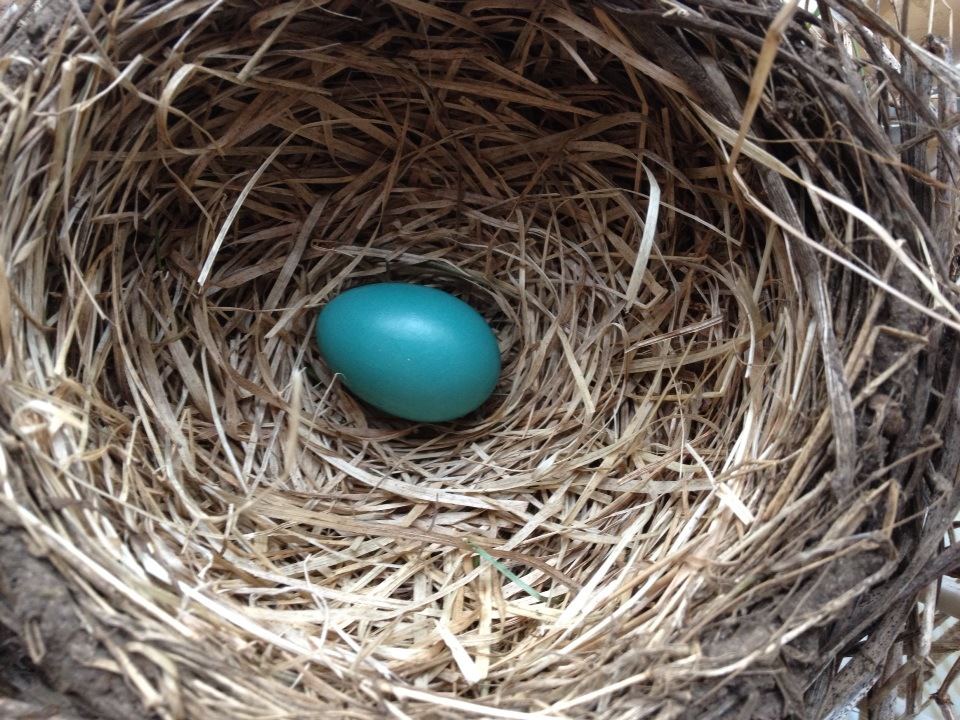
Figure 14. American Robin egg. Photo credit: Olivia Smith.
House Finch (Haemorhous mexicanus)
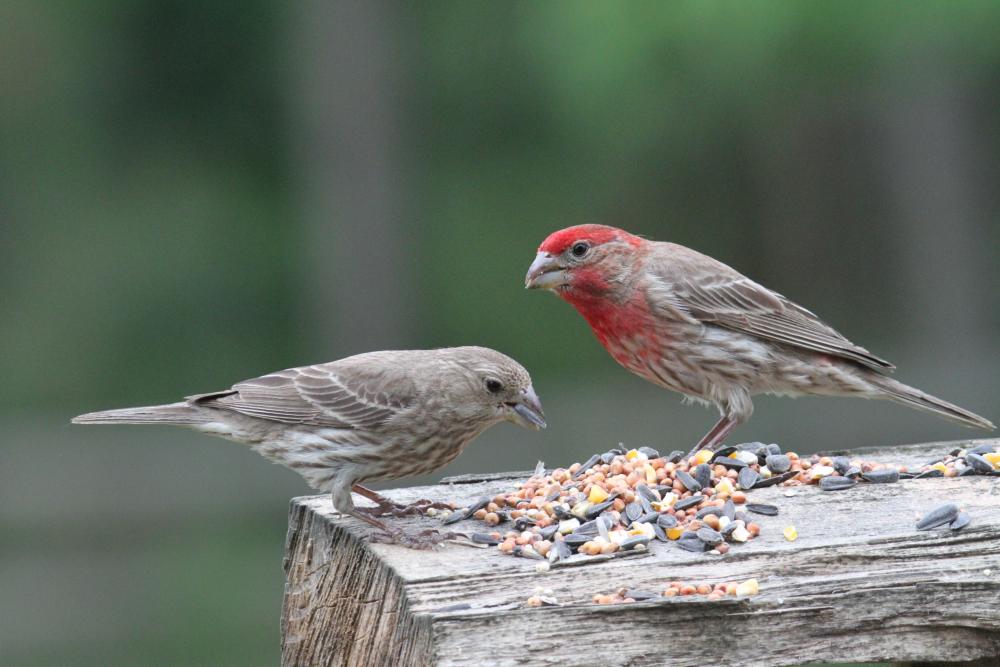
Figure 15. House Finch female (left) and male (right) eating seeds. Males have a bright red throat, belly, cap, and nape. Intensity of red color indicates male health. Females are drab but can be distinguished from other species by the sturdy, seed cracking bill. House Finches also have streaking on the breast that distinguishes them from similar looking House Sparrows. Photo credit: John Flannery, The House Finches, CC BY-ND 2.0
The House Finch (Fig. 15) is native to the deserts and dry, open habitats of the southwestern United States. In 1939, several birds were released from a pet store in New York City, allowing a range expansion into the eastern United States. The western population has also expanded its range so that now the House Finch occurs across most of the United States and Mexico. Nests can be placed in a large variety of sites: pine, palm trees, cacti, rock ledges, ivy on buildings, street lamps, hanging planters, parking structures, lean-tos, window sills, in the cavities of various farm equipment, etc. Nests are open cup and built from grass, leaves, rootlets, small twigs, string, wool, and feathers (Fig. 16). In urban areas, birds will incorporate human items such twine, string, dog hair, cellophane, and even cigarette filters (Badyaev et al., 2012). House Finches are known to carry E. coli (Morishita et al., 1999) and Salmonella enterica (Kirk et al., 2002), so nesting near food processing areas should be discouraged.
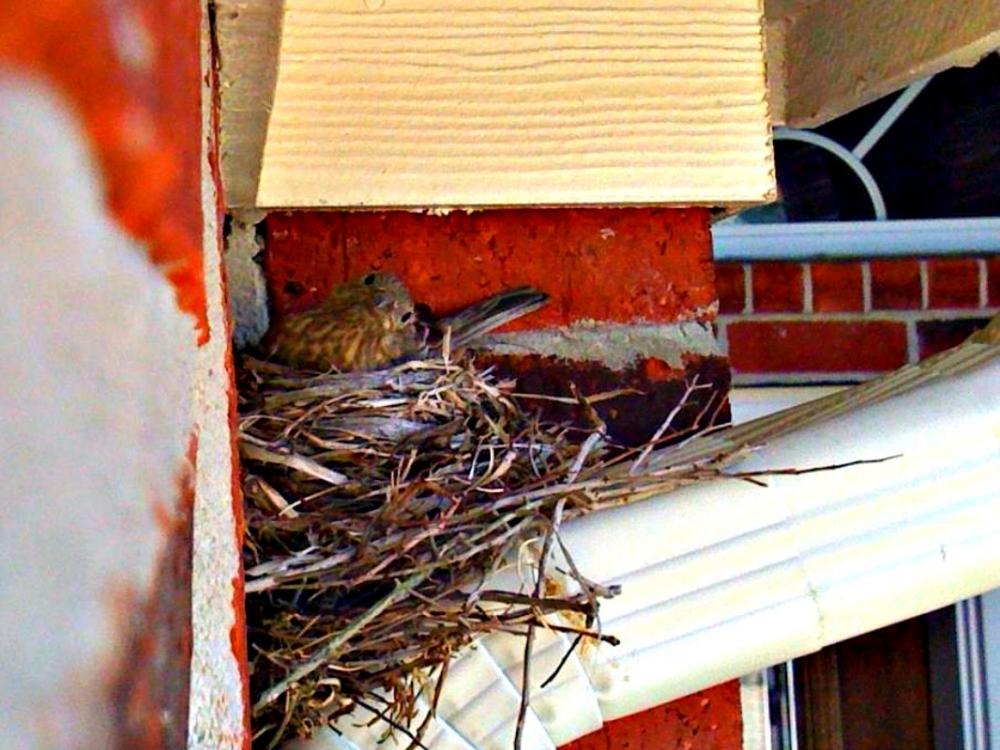
Figure 16. House Finch female sitting on open cup nest placed on gutter. Photo credit: Robert Hruzek, House Finch – Detail, CC BY-NC-ND 2.0
Nest building begins in February in the southwest portion of the range and March in the northern portion. Birds can nest up to 6 times per year but have only been observed to have 3 successful broods a season. Eggs are pale blue to white with black and pale purple speckles. Egg shape is sub-elliptical to long sub-elliptical and ranges from 1.6–2.1 cm in length by 1.2–1.8 cm in width. Incubation can take between 12–17 days and averages 13–14. Fledglings typically take 2.5–3 weeks to feed themselves completely independently from parents (Badyaev et al., 2012). Young are thought to eat mostly weed seeds with very little insect matter in the diet (<2%; Beal, 1907). House Finch adults are granivorous (Wilman et al., 2014).
Barn Owl (Tyto alba)
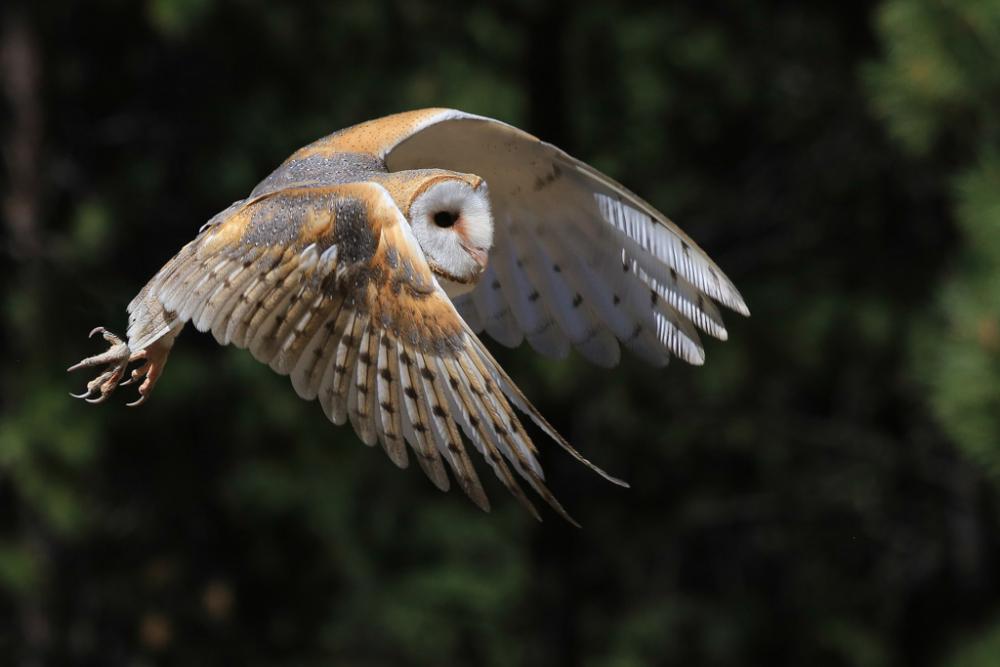
Figure 17. Barn Owl in flight. Photo credit: Robert Shea, Barn Owl, CC BY-NC 2.0
Like the Barn Swallow, the Barn Owl (Fig. 17) has a nearly global distribution. It is typically found in open habitats such as pastures and farm fields rather than closed, forested habitats. Barn Owls are nocturnal and most likely to be seen around dawn and dusk. The Barn Owl has a piercing shriek (example recording here) that can also give away its occupancy. Barn Owls nest in cavities including tree cavities, cliffs, church steeples, barn lofts, haystacks, and nest boxes (Fig. 18). Suitable nesting locations is a limiting factor for this beneficial raptor, so providing nest boxes is important (Marti et al., 2005; click here for more information on construction and placement). Barn owls are known to carry Salmonella spp. (Kirkpatrick and Colvin, 1986), antibiotic resistant E. coli (Alcalá et al., 2016), and Campylobacter spp. (Molina-Lopez et al., 2011), perhaps from feeding on mice carrying these bacteria.
Figure 18. Barn Owl nest box. Photo credit: Olivia Smith.
The Barn Owl does not usually build nests, though some dig burrows in arroyo walls in Colorado and New Mexico. Because of its wide distribution, egg laying initiation date varies and can occur year-round. One brood is common for birds in temperate regions, but some pairs have 3 broods per year. Average clutch size ranges from 3.1 to 7.2, depending on location. Eggs are short sub-elliptical, are about 3.2–3.4 cm in length by 4.0–4.4 cm in width, and dull white. The female incubates eggs for 29–34 days. Fledging date varies based on location. In England, first flight is usually day 50–55, whereas in Utah, mean fledging date is day 64. Fledglings are dependent on adults for 3–5 weeks. Fledglings are clumsy until they gain enough strength and agility to fly (Fig. 18). Chicks and adults eat the same diet, which is mostly small mammals, including common rodent pests (Moore et al., 1998; Marti et al., 2005; Wilman et al., 2014). However, evidence that Barn Owls increase yield through pest control services is still sparse (Moore et al., 1998), though Motro (2011) did find an estimated alfalfa yield increase of 3.2% due to Barn Owls, equating to $30/ha per year.
Figure 19. Barn Owl day of fledging. Photo credit: Olivia Smith.
Nest Location Management
It is illegal to tamper with nests or eggs of native species, so deterrence of nesting in unwanted locations before it begins is important. Avoid using poisons or methods that can harm or kill native species. Below are a few commonly recommended methods for deterring bird nesting on structures. More research is needed to test the efficacy of listed methods. Most methods are best initiated and maintained prior to the onset of the breeding season.
- Block cavity entrances using mesh, wood, or other barriers (see nest in Fig. 2 above for an example this method could help with). Place netting carefully to avoid birds getting trapped inside (but see Fig. 4).
- Create slopes on ledges by placing boards at a 45 degree angle so that species like Rock Pigeon cannot build nests. If a board doesn't work, try a loose spring that creates an unstable surface for birds to build on. Spikes are also an option, but be aware spikes can kill birds. A quick internet search shows many examples of nests built on top of spikes, suggesting they are ineffective, and will also show photos of impaled birds.
- Create a visual disturbance near nest sites by using flashing lights, placing mirrors on ledges, or hanging mylar tape. However, species like the European Starling are extremely smart and aren't fooled for long with these methods (Belant et al., 1998).
- Place plastic predators near nests. These need to be moved frequently to continue to deter birds (Belant et al., 1998).
- Use noise machines that project bird distress or predator calls. However, there is no current evidence to suggest this method works.
- Plant shrubs that provide good nesting habitat away from structures. Try planting near crops where birds will eat pest insects (like apples; Mols and Visser, 2002), but avoid placing next to crops birds will damage (cherries, blueberries, grapes; Somers et al., 2002). Prior research has demonstrated pest control services increase near natural habitat like hedges (Boesing et al., 2017).
Find ways to encourage nesting at The Cornell Lab of Ornithology’s Project NestWatch website, which has excellent information on how to promote nesting for many species, including many farmland birds not listed in this article.
Additional Resources
The Cornell Lab of Ornithology supports a great citizen scientist network with detailed information on nest box construction and placement (nestwatch.org), recommendations for attracting species of interest (content.yardmap.org), and range information (ebird.org). Project NestWatch also has great information on identifying many nests beyond the scope of this article (https://nestwatch.org/learn/focal-species/). The lab offers many opportunities for the public to get involved with scientific data collection through HabitatNetwork, Project FeederWatch, eBird, and NestWatch. Basic species information can be found at All About Birds, and the Merlin Bird ID app can aid in field identification.
References and Citations
- Alcalá, L., C. A. Alonso, C. Simón, C. González-Esteban, J. Orós, A. Rezusta, C. Ortega, and C. Torres. 2016. Wild birds, frequent carriers of extended-spectrum β-lactamase (ESBL) producing Escherichia coli of CTX-M and SHV-12 types. Microbial Ecology 72:861–869. Available online at: https://link.springer.com/article/10.1007/s00248-015-0718-0 (verified 13 May 2018).
- Badyaev, A. V., V. Belloni, and G. E. Hill. 2012. House Finch (Haemorhous mexicanus). In P. Rodewald (ed.) The Birds of North America. Cornell Lab of Ornithology, Ithaca, NY. Available online at: https://birdsna.org/Species-account/bna/species/houfin/introduction (verified 31 May 2018).
- Beal, E.E.L. 1907. Birds of California in relation to the fruit industry, Part 1. Biological Survey Bulletin no. 30. USDA Biological Survey, Washington, D.C.
- Belant, J. L., P. P. Woronecki, R. A. Dolbeer, and T. W. Seamans. 1998. Ineffectiveness of five commercial deterrents for nesting starlings. Wildlife Society Bulletin 26:264–268. Available online at: http://www.jstor.org/stable/3784047 (verified 13 May 2018).
- Boesing, A. L., E. Nichols, and J. P. Metzger. 2017. Effects of landscape structure on avian-mediated insect pest control services: A review. Landscape Ecology 32:931-944. Available online at: https://link.springer.com/article/10.1007/s10980-017-0503-1 (verified 17 April 2018).
- Brown, C. R., and M. B. Brown. 1999. Barn Swallow (Hirundo rustica). In P. Rodewald (ed.) The Birds of North America. Cornell Lab of Ornithology, Ithaca, NY. Available online at: https://birdsna.org/Species-Account/bna/species/barswa (verified 19 March 2018).
- Brown, C. R., M. B. Brown, P. Pyle, and M. A. Patten. 2017. Cliff Swallow (Petrochelidon pyrrhonota). In P. Rodewald (ed.) The Birds of North America. Cornell Lab of Ornithology, Ithaca, NY. Available online at: https://birdsna.org/Species-Account/bna/species/cliswa (verified 21 March 2018).
- Cabe, P. R. 1993. European Starling (Sturnus vulgaris). In P. Rodewald (ed.) The Birds of North America. Cornell Lab of Ornithology, Ithaca, NY. Available online at: https://birdsna.org/Species-Account/bna/species/eursta (verified 19 March 2018).
- Carlson, J. C., A. B. Franklin, D. R. Hyatt, S. E. Pettit, and G. M. Linz. 2011. The role of starlings in the spread of Salmonella within concentrated animal feeding operations. Journal of Applied Ecology 48:479–486. Available online at: https://doi.org/10.1111/j.1365-2664.2010.01935.x (verified 19 March 2018).
- Grant, G. S., and T. L. Quay. 2017. Breeding biology of Cliff Swallows in Virginia. The Wilson Bulletin 89:286–890. Available online at: http://www.jstor.org/stable/4160910 (verified 21 March 2018).
- Howell, J. C. 1942. Notes on the nesting habits of the American Robin (Turdus migratorius L.). The American Midland Naturalist 28:529–603. Available online at: http://www.jstor.org/stable/2420891 (verified 17 April 2018).
- Kessel, B. 1957. A study of the breeding biology of the European Starling (Sturnus vulgaris L.) in North America. The American Midland Naturalist 58:257–331. Available online at: http://www.jstor.org/stable/2422615 (verified 19 March 2018).
- Kirk, J. H., C. A. Holmberg, and J. S. Jeffrey. 2002. Prevalence of Salmonella spp in selected birds captured on California dairies. Journal of the American Veterinary Medical Association 220:359–362. Available online at: https://doi.org/10.2460/javma.2002.220.359 (verified 17 April 2018).
- Kirkpatrick, C. E., and B. A. Colvin. 1986. Salmonella spp. in nestling common barn-owls (Tyto alba) from Southwestern New Jersey. Journal of Wildlife Diseases 22: 340–343. Available online at: https://europepmc.org/abstract/med/3525874 (verified 14 May 2018).
- Kobayashi, H., M. Kanazaki, E. Hata, and M. Kubo. 2009. Prevalence and characteristics of eae- and stx- positive strains of Escherichia coli from wild birds in the immediate environment of Tokyo Bay. Applied Environmental Microbiology 75:292–295. Available online at: http://aem.asm.org/content/75/1/292.full (verified 19 March 2018).
- Lowther, P. E., and C. L. Cink. 2006. House Sparrow (Passer domesticus). In P. Rodewald (ed.) The Birds of North America. Cornell Lab of Ornithology, Ithaca, NY. Available online at: https://birdsna.org/Species-Account/bna/species/houspa (verified 19 March 2018).
- Lowther, P. E., and R. F. Johnston. 2014. Rock Pigeon (Columba livia). In P. Rodewald (ed.) The Birds of North America. Cornell Lab of Ornithology, Ithaca, NY. Available online at: https://birdsna.org/Species-Account/bna/species/rocpig (verified 19 March 2018).
- Marti, C. D., A. F. Poole, and L. R. Bevier. 2005. Barn Owl (Tyto alba). In P. Rodewald (ed.) The Birds of North America. Cornell Lab of Ornithology, Ithaca, NY. Available online at: https://birdsna.org/Species-Account/bna/species/brnowl (verified 14 May 2018).
- Molina-Lopez, N. Valverdú, M. Martin, E. Mateu, E. Obon, M. Cerdà-Cuéllar, and L. Darwich. 2011. Wild raptors as carriers of antimicrobial-resistant Salmonella and Campylobacter strains. Veterinary Record 168:565. Available online at: http://dx.doi.org/10.1136/vr.c7123 (verified 13 May 2018).
- Mols, C.M.M., and M. E. Visser. 2002. Great tits can reduce caterpillar damage in apple orchards. Journal of Applied Ecology 39:888–899. Available online at: https://doi.org/10.1046/j.1365-2664.2002.00761.x (verified 24 April 2018).
- Moore, T., D. V. Vuren, and C. Ingels. 1998. Are Barn Owls a biological control for gophers? Evaluating effectiveness in vineyards and orchards. Proceedings of the Eighteenth Vertebrate Pest Conference 61:394–396. Available online at: https://pdfs.semanticscholar.org/0447/40f70698eb13d3e90cd5d2486551f2b5d75a.pdf (verified 14 May 2018).
- Morishita, T. Y., P. P. Aye, E. C. Ley, and B. S. Harr. 1999. Survey of pathogens and blood parasites in free-living passerines. Avian Diseases 43:549–552. Available online at: http://www.jstor.org/stable/1592655 (verified 19 March 2018).
- Motro, Y. 2011. Economic evaluation of biological rodent control using barn owls Tyto alba in alfalfa. European Vertebrate Pest Management Conference 8:79–80. Available online at: https://www.researchgate.net/publication/304922042_Economic_evaluation_of_biological_rodent_control_using_barn_owls_Tyto_alba_in_alfalfa (verified 31 May 2018).
- Nielsen, E. M., M. N. Skov, J. J. Madsen, J. Lodal, J. B. Jespersen, and D. L. Baggesen. 2004. Verocytotoxin-producing Escherichia coli in wild birds and rodents in close proximity to farms. Applied Environmental Microbiology 70:6944–6947. Available online at: http://aem.asm.org/content/70/11/6944.full (verified 19 March 2018).
- Ricklefs, R. E., and C. A. Smeraski. 1983. Variation in incubation period within a population of the European Starling. The Auk 100:926–931. Available online at: http://www.jstor.org/stable/4086421 (verified 19 March 2018).
- Sejkora, P., M. J. Kirisits, and M. Barrett. 2011. Colonies of Cliff Swallows on highway bridges: A source of Escherichia coli in surface waters. Journal of the American Water Resources Association 47:1275–1284. Available online at: https://doi.org/10.1111/j.1752-1688.2011.00566.x (verified 21 March 2018).
- Shields, W. M., and J. R. Crook. 1987. Barn Swallow coloniality: A net cost for group breeding in the Adirondacks? Ecology 68:1373–1386. Available online at: http://www.jstor.org/stable/1939221 (verified 19 March 2018).
- Somers, C. M., and R. D. Morris. 2002. Birds and wine grapes: Foraging activity causes small-scale damage patterns in single vineyards. Journal of Applied Ecology 39:511–523. Available online at: https://doi.org/10.1046/j.1365-2664.2002.00725.x (verified 13 May 2018).
- Vanderhoff, N. P. Pyle, M. A. Patten, R. Sallabanks, and F. C. James. 2016. American Robin (Turdus migratorious). In P. Rodewald (ed.) The Birds of North America. Cornell Lab of Ornithology, Ithaca, NY. Available online at: https://birdsna.org/Species-Account/bna/species/amerob (verified 17 April 2018).
- Weatherhead, P. J., and S. B. Mcrae. 1990. Brood care in American Robins: Implications for mixed reproductive strategies by females. Animal Behaviour 39:1179–1188. Available online at: https://doi.org/10.1016/S0003-3472(05)80790-0 (verified 17 April 2018).
- Williams, M. L., D. L. Pearl, and J. T. LeJeune. 2011. Multiple‐locus variable‐nucleotide tandem repeat subtype analysis implicates European starlings as biological vectors for Escherichia coli O157:H7 in Ohio, USA. Journal of Applied Microbiology 111:982–988. Available online at: https://doi.org/10.1111/j.1365-2672.2011.05102.x (verified 19 March 2018).
- Wilman, H., J. Belmaker, J. Simpson, C. de la Rosa, M. M. Rivadeneira, and W. Jetz. 2014. EltonTraits 1.0: Species-level foraging attributes of the world's birds and mammals. Ecology 95:2027–2027. Available online at: https://esajournals.onlinelibrary.wiley.com/doi/abs/10.1890/13-1917.1 (verified 13 May 2018).
- Wolf, B. O. 1997. Black Phoebe (Sayornis nigricans). In P. Rodewald (ed.) The Birds of North America. Cornell Lab of Ornithology, Ithaca, NY. Available online at: https://birdsna.org/Species-Account/bna/species/blkpho (verified 13 May 2018).



